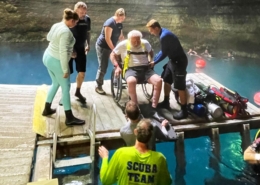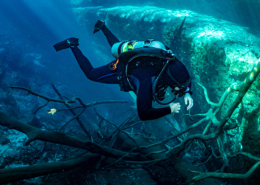Improving Your Sense of Direction Under Water
By: Kate Heller
Where’s the boat? Did we pass this part of the reef already? Should we just go up? Whether it happens to a new diver or an experienced one, there will more than likely come a time where navigating under water will become difficult. For a new diver who’s excited to experience the underwater world without an instructor, the difficulty might come when it’s time to head back to the boat or when the buddy team gets turned around. An experienced diver might have trouble when diving in a new place where conditions are not what they are accommodated to. For instance, a diver who is used to the visibility in an ocean and travels to a quarry and experiences less than decent visibility for the first time. All the silt from the bottom that’s been stirred up from the day before could cause the diver to lose track of their surroundings. This is when being not only being able to navigate underwater with a compass comes in handy, but when other methods of navigation can and should be utilized as well.
1. Know your compass
A diver should know what the parts of a compass are and what they are used for.
The card is the part of the compass that always points to the north. It will display N, S, E, and W on it. The card is shaped a bit like a dome with degrees shown on the face. These numbers will allow the diver to see what direction they are traveling, for example, 45 degrees SW.
The lubber line is used to point the buddy team in the direction they want to go. The person in charge of the compass should hold it out in front of them and in line with their body.
The side window of a compass is used along with the lubber line. When the lubber line is pointed in the direction the buddy team wants to travel, that window shows the degree to which the team is heading.
The bezel remembers the original degree the team wanted to travel. Once the lubber line is set in the direction of travel, the leader of the buddy team will have to turn the bezel to where the card points to North. Make sure to put the “N” between the two tick marks on the bezel.
2. Listen to the boat briefing or ask a dive shop about a particular shore site.
Knowing a bit more about the orientation at any given site will not only help you plan your dive based on what you want to see but also help you with navigating. Often times a briefing from a crew member on the boat will include what to look for from any given point of the boat (bow, stern, port, and star port side).
3. Elect and follow a leader.
When planning a dive within a buddy team you’ll want to delegate a person as the leader. This person is going to be in charge of the compass. So as to not leave the other member of the team out, they will need to help guide the leader by looking out for obstacles, as well as possible landmarks.
4. Monitor your time.
On a boat, the captain will normally give you an amount of time that they’ll allow divers to stay underwater. Using and dive computer as a reference of time will help you to do a little math to figure out how long the buddy team has to look at the underwater world as well as having enough time to return. If a dive is being planned for a shore dive, the buddy team will want to decide on a time collectively. In both cases, the buddy team will need to make it a point to set their air limits to stay safe.
5. Get to know your surroundings.
Keeping in mind the dive briefing for the site the team is at, the next step would be to look around at your surroundings and keep in mind what you’ve seen around the boat. Once the buddy team has decided on a direction to travel, made a note of the degree you’ll need to travel back to the boat on your compass, and set your lubber line for the direction you want to travel, the team can continue on their adventure. Once you’re on your way, look for the landmarks along the way and either make a mental note of them or write them on a slate if you have one. This will help you to follow a path if one is not apparent underwater. However, sometimes there are paths underwater. If you’re on a reef you might find yourself swimming between a couple rock formations with corals and schools of fish hanging around. You can follow this path and make a note of the things you see to keep yourselves on track. In the same respect, on a shore dive, you might be able to follow a trail made in the sand by waves. Remember to check your compass as well as your air and time to be sure you’re staying within those limits.
6. Stop, Look, Listen.
If for some reason the bezel on the compass got bumped and you can’t remember the directional degree the boat was, then you’ll want to keep in mind these tips. First, stop and think about your dive thus far. Second, look around for the landmarks that you made notes of along the dive. Third, listen for the boat’s engine. Remember sounds travels 4 times faster underwater than on land and although it might be harder to depict where the sounds are coming from, you might be able to pick out the general direction of the boat. If all else fails and you think you might be way off course, ascend at the appropriate rate and look for the boat at the surface. Once you spot the boat, take a new heading in the direction of the boat and follow that. If you are doing a shore dive you can look at the pattern in the sand and follow that to shore. You’ll quickly notice that your depth gets shallower and shallower.
7. Practice.
Like anything else in life, the best thing you and a buddy team can do for your skills is to practice. To do that all you need to do is get out and dive. Remember to incorporate your compass and other navigational skills into every dive you do and you’ll keep getting better and learning more about navigating in an underwater environment.
Navigating under water to new divers can seem intimidating without a guide or knowledge of the dive site, but with these tips in mind, it will become easier. Eventually, navigating under water will become second nature.










Skriv en kommentar
Vil du deltage i diskussionen ?Du er velkommen til at bidrage !